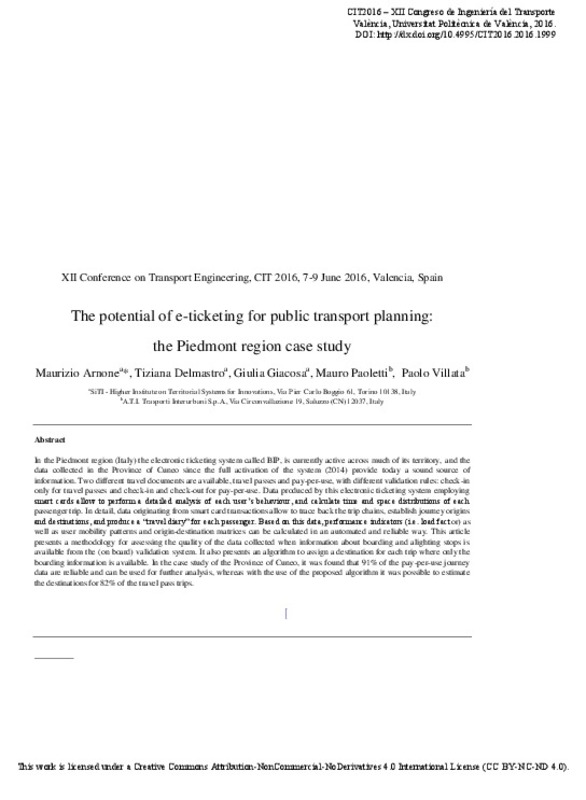JavaScript is disabled for your browser. Some features of this site may not work without it.
Buscar en RiuNet
Listar
Mi cuenta
Estadísticas
Ayuda RiuNet
Admin. UPV
The potential of e-ticketing for public transport planning: the Piedmont region case study
Mostrar el registro sencillo del ítem
Ficheros en el ítem
| dc.contributor.author | Arnone, Maurizio
|
es_ES |
| dc.contributor.author | Delmastro, Tiziana
|
es_ES |
| dc.contributor.author | Giacosa, Giulia
|
es_ES |
| dc.contributor.author | Paoleti, Mauro
|
es_ES |
| dc.contributor.author | Villalta, Paolo
|
es_ES |
| dc.coverage.spatial | east=7.515388499999972; north=45.0522366; name=10098 Rivoli, Província de Torí, Itàlia | |
| dc.date.accessioned | 2017-07-12T07:13:17Z | |
| dc.date.available | 2017-07-12T07:13:17Z | |
| dc.date.issued | 2016-06-01 | |
| dc.identifier.isbn | 9788460899600 | |
| dc.identifier.uri | http://hdl.handle.net/10251/84980 | |
| dc.description.abstract | [EN] In the Piedmont region (Italy) the electronic ticketing system called BIP, is currently active across much of its territory, and thedata collected in the Province of Cuneo since the full activation of the system (2014) provide today a sound source ofinformation. Two different travel documents are available, travel passes and pay-per-use, with different validation rules: check-inonly for travel passes and check-in and check-out for pay-per-use. Data produced by this electronic ticketing system employingsmart cards allow to perform a detailed analysis of each user’s behaviour, and calculate time and space distributions of eachpassenger trip. In detail, data originating from smart card transactions allow to trace back the trip chains, establish journey originsand destinations, and produce a “travel diary” for each passenger. Based on this data, performance indicators (i.e. load factor) aswell as user mobility patterns and origin-destination matrices can be calculated in an automated and reliable way. This articlepresents a methodology for assessing the quality of the data collected when information about boarding and alighting stops isavailable from the (on board) validation system. It also presents an algorithm to assign a destination for each trip where only theboarding information is available. In the case study of the Province of Cuneo, it was found that 91% of the pay-per-use journeydata are reliable and can be used for further analysis, whereas with the use of the proposed algorithm it was possible to estimatethe destinations for 82% of the travel pass trips.DOI: http://dx.doi.org/10.4995/CIT2016.2016.1999 | es_ES |
| dc.format.extent | 8 | es_ES |
| dc.language | Inglés | es_ES |
| dc.publisher | Editorial Universitat Politècnica de València | es_ES |
| dc.relation.ispartof | XII Congreso de ingeniería del transporte. 7, 8 y 9 de Junio, Valencia (España) | es_ES |
| dc.rights | Reconocimiento - No comercial - Sin obra derivada (by-nc-nd) | es_ES |
| dc.subject | INGENIERÍA DEL TRANSPORTE | es_ES |
| dc.title | The potential of e-ticketing for public transport planning: the Piedmont region case study | es_ES |
| dc.type | Capítulo de libro | es_ES |
| dc.type | Comunicación en congreso | es_ES |
| dc.identifier.doi | 10.4995/CIT2016.2015.1999 | |
| dc.rights.accessRights | Abierto | es_ES |
| dc.description.bibliographicCitation | Arnone, M.; Delmastro, T.; Giacosa, G.; Paoleti, M.; Villalta, P. (2016). The potential of e-ticketing for public transport planning: the Piedmont region case study. En XII Congreso de ingeniería del transporte. 7, 8 y 9 de Junio, Valencia (España). Editorial Universitat Politècnica de València. 2380-2387. https://doi.org/10.4995/CIT2016.2015.1999 | es_ES |
| dc.description.accrualMethod | OCS | es_ES |
| dc.relation.conferencename | CIT2016. Congreso de Ingeniería del Transporte | es_ES |
| dc.relation.conferencedate | June 07-09,2016 | es_ES |
| dc.relation.conferenceplace | Valencia, Spain | es_ES |
| dc.relation.publisherversion | http://ocs.editorial.upv.es/index.php/CIT/CIT2016/paper/view/1999 | es_ES |
| dc.description.upvformatpinicio | 2380 | es_ES |
| dc.description.upvformatpfin | 2387 | es_ES |
| dc.type.version | info:eu-repo/semantics/publishedVersion | es_ES |
| dc.relation.pasarela | OCS\1999 | es_ES |








